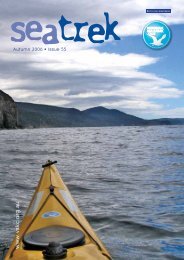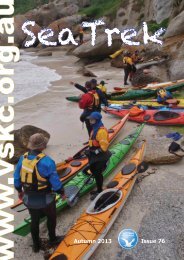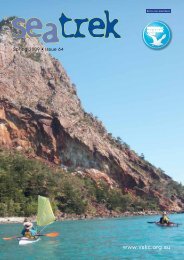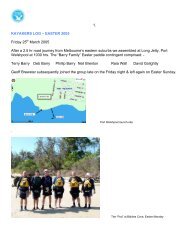Sea Trek Issue 70 - Victorian Sea Kayak Club
Sea Trek Issue 70 - Victorian Sea Kayak Club
Sea Trek Issue 70 - Victorian Sea Kayak Club
Create successful ePaper yourself
Turn your PDF publications into a flip-book with our unique Google optimized e-Paper software.
24 degrees!!!! No need for sleeping bags,<br />
jumpers, thermals wetsuits or shoesshould<br />
have left them at home.<br />
About an hour into the first day we had a<br />
tropical downpour, but it was warm even<br />
paddling in a cotton shirt. The shower<br />
lasted less than half an hour and was<br />
replaced by clear blue sky. The only<br />
other rain we had was on two nights and<br />
one afternoon.<br />
Having paddled the Whitsunday Islands a<br />
number of times I was pleasantly surprised<br />
to find Vava’u even more stunning.<br />
The clear deep water is a myriad of<br />
blue colours that defy description, lush<br />
tropical foliage covers the islands, white<br />
sand beaches, very friendly locals, few<br />
tourists and you really got the feeling of<br />
experiencing the culture of the place. One<br />
of the great benefits I found was that are<br />
few biting insects, no sand or march flies,<br />
just some mosquitoes and wasps. The<br />
latter of which I was glad we didn’t have<br />
a problem with. Having never been on<br />
an ‘escorted tour’ before it took a bit of<br />
getting used to not having to cook or<br />
clean anything, having base camp set up<br />
for you and receiving 3 delicious meals a<br />
day served with a smile by our friendly<br />
guides.<br />
About <strong>70</strong>% of the population of 20,000<br />
have no income and live off the land and<br />
sea, as has been the case for over 2000<br />
years, so I was a little disappointed by the<br />
lack of fish and coral quality compared to<br />
the Whitsundays but not surprised. The<br />
cultural experience, description defying<br />
beauty of the environment and beautiful<br />
weather more than made up for this.<br />
We fortunately planned to arrive a couple<br />
of days before our kayak trip and found<br />
this to be of great benefit. It allowed us to<br />
settle in to ‘Tongan time’ and explore<br />
Neiafu shopping for last minute items as<br />
well as going on a ‘whale swim’. This<br />
was a highlight of our trip and we now<br />
have lifetime memories of snorkelling<br />
with humpback whales which were as<br />
interested in us as we were of them. I<br />
couldn’t believe I was eye to eye within<br />
touching distance of one of these creatures<br />
as it swam to us to check both the<br />
boat and us out. A feeling that’s difficult<br />
to describe. We also went snorkelling at<br />
Mariners Cave which is entered by a two<br />
meter dive for about 4 meters. The light<br />
reflects into the cave making the inside<br />
take on a magical glow made even more<br />
special by a fog that appears each time<br />
the swell surges in and out, apparently<br />
caused by the compression and decompression<br />
of the air inside. David made a<br />
heroic dive to get himself inside the cave<br />
but then wondered how the hell he was<br />
going to ever get out again having used<br />
all his energy to get there in the first<br />
place. Ever the friend and great leader, I<br />
took his picture so Heather would have<br />
some memory of him and left him to it!<br />
He emerged a minute or so later none the<br />
worse for wear but a little red faced. We<br />
then went on to Swallows cave, a famous<br />
cave of enormous proportions which we<br />
explored on snorkel and later returned to<br />
in sea kayaks in the coming days.<br />
The paddling each day was quite easy,<br />
the trips are catered for novices. The<br />
whole area is easy paddling territory,<br />
little fetch between the bodies of water<br />
surrounding the islands. Always a stunning<br />
vista around every corner and plenty<br />
of places to stop and stretch the legs.<br />
Each morning we were treated to a delicious<br />
cooked breakfast and a leisurely<br />
pack up before departing for our next<br />
island, and paddle times were commonly<br />
around 4hours.<br />
Our guides knew these waters well and<br />
being with them enabled us to hear the<br />
traditional stories of the formation and<br />
history of the area as well as access to<br />
many of the villages en route to resupply<br />
with fresh water. We were treated to a<br />
traditional ‘umu’ feast .We dressed in our<br />
finest Lava Lava’s brought especially for<br />
the occasion, the locals were quite bemused<br />
as they hadn’t seen tartan lava<br />
lava before, David had imported his one<br />
specially. The village had prepared a<br />
feast which we were led to, laid out on a<br />
low table inside what turned out to be the<br />
old school room. Most food was traditionally<br />
wrapped in leaves with a young<br />
suckling pig as the centre piece.<br />
The guides explained the various foods<br />
which included fish, beef, abalone (actually<br />
turban shell) octopus, raw fish and<br />
many tropical fruits, all of course cooked<br />
in coconut milk! We were then invited to<br />
join in a Kava drinking session accompanied<br />
by beautiful music and singing.<br />
Kava is the dried and ground up root of<br />
the Kava plant, soaked in water and<br />
strained through cloth to form a muddy<br />
looking brew. It is then placed in a traditional<br />
bowl and drunk from a half coconut<br />
shell. If you want a drink just clap<br />
and the cup is passed to you, two claps<br />
means a full cup.<br />
Best skulled, as it has what some call a<br />
disgusting taste, it numbs the lips and<br />
tongue and has a somewhat anaesthetic<br />
effect if you drink enough. The locals sit<br />
in the kava circle for hours each evening.<br />
The routine seemed to be sing a song,<br />
drink some Kava, have a smoke, drink<br />
more Kava and sing again. This was<br />
repeated over and over. The singing and<br />
music was delightful.<br />
We were fortunate enough to have a second<br />
umu on our last night as a special<br />
treat from the guides. Fresh fish was<br />
caught for the occasion. It was fascinating<br />
watching the whole preparation and<br />
cooking process from start to finish.<br />
We also did our bit for the environment.<br />
FIKCO promote themselves as an ecofriendly<br />
company and so we collected<br />
rubbish washed up on the beaches where<br />
we camped. This we left in garbage bags<br />
for latter collection by boat. The volume<br />
of rubbish washed up on the beaches is<br />
astounding. Much from far away places,<br />
but also disappointingly a fair bit left by<br />
the locals, including broken glass. Footware<br />
is unfortunately a necessity.<br />
By the end of the trip we had made new<br />
friends from all those on the trip as well<br />
as the guides and had experienced real<br />
Polynesian culture and hospitality that we<br />
would never have had in other tourist<br />
type destinations. No wonder this was the<br />
place that Mutiny on The Bounty occurred!<br />
Deb and I were also lucky enough to<br />
spend a further eight nights post-trip<br />
chilling out at the Tongan Beach resort .<br />
I don’t think we could wind down any<br />
further without being in a coma!<br />
Would we go again? You bet!<br />
If you want to know more details of the<br />
trip be at Phillip Island Paddle Fest in<br />
November where the Tongan trip will be<br />
a feature on Friday night.<br />
15













